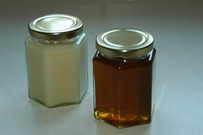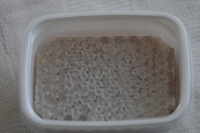Honey and Wax

There are two types of honey and in simple terms, these are liquid and crystallised. The terms are self-explanatory. All honeys will crystallise, given enough time, some doing so without any intervention from the beekeeper in a matter of weeks. The natural conversion from liquid to crystallised is caused by the different sugars contained in the nectars gathered from the flowers worked by the bees. Crystallised honey will revert to liquid if gently warmed for a short period. There is a wide variety of honey produced by bees and the colour and flavour depends on the flowers from which they obtained nectar.
Honey is extracted from the wax comb produced by the bees using a centrifugal extractor. Other than filtration, nothing further needs to be done to the honey and certainly it is not possible to improve on the high quality achieved by the bees themselves.

Many people like their honey still in the comb. This is called cut comb and is the purest form of honey, being exactly as the bees left it in the comb. It is normally rather more expensive than buying honey in the jar, but well worth the price!
A by-product of honey extraction is beeswax and whilst many beekeepers choose to recycle this, others refine it to provide the very highest quality wax and use this in the creation of candles, soap, hand-cream, polish, lip balm and other natural cosmetics.
For more information on honey click here
